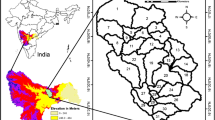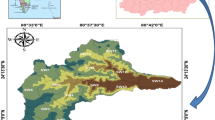Abstract
The identification of critical sub-watersheds susceptible to soil erosion risk is the preliminary step in any watershed management plan. To achieve this goal, it is crucial to prioritize sub-watersheds based on morphometric characteristics. This study was performed on the Upper Shimsha-1 watershed using a digital elevation model to quantify the morphometric parameters. The stream network was extracted using ArcGIS software, and the watershed was delineated into 16 sub-watersheds (denoted as SW1–SW16). Two approaches, namely, the fuzzy analytical hierarchy process (FAHP) and compound parameter analysis, were employed to prioritize sub-watersheds using 18 parameters highly related to soil erodibility. The FAHP score ranged from 0.145 (lowest priority) to 0.795 (highest priority), classifying sub-watersheds into ‘high’, ‘medium’ and ‘low’ classes occupying 10.76%, 27.23% and 62.01% of the total area, respectively. The compound parameter values ranged from 6.05 (highest priority) to 10.77 (lowest priority), and the ‘high’, ‘medium’ and ‘low’ classes occupied 31.84%, 16.49% and 51.67% of the total area, respectively. Common sub-watersheds identified as ‘high’ priority by both methods were SW14 and SW15, accounting for 10.76%, whereas under the ‘low’ priority class, SW1, SW8, SW9, SW11, SW12 and SW16 accounted for 42.66% of the total area. Consequently, eight sub-watersheds were found to be common in both prioritization methods corresponding to their respective priority classes. Through this investigation, the integration of GIS technology, morphometry and prioritization methods has proven to be indispensable in watershed management and soil conservation efforts. The findings further emphasize the urgent need for attention from decision-makers toward critical sub-watersheds.



Similar content being viewed by others
Data availability
The data supporting the findings of this study are available within the paper and its supplementary information/online resource files available from figshare repository: https://doi.org/10.6084/m9.figshare.24899277.v2 (Dhanush et al. 2023).
References
Abdo HG, Almohamad H, Al Dughairi AA, Karuppannan S (2023) Sub-basins prioritization based on morphometric analysis and geographic information systems: a case study of the Barada river basin, Damascus countryside governorate, Syria. Proceedings of the Indian national science academy 1–10. https://doi.org/10.1007/s43538-023-00168-8
Al-Saady YI, Al-Suhail QA, Al-Tawash BS, Othman AA (2016) Drainage network extraction and morphometric analysis using remote sensing and GIS mapping techniques (lesser Zab River Basin, Iraq and Iran). Environ Earth Sci 75:1–23. https://doi.org/10.1007/s12665-016-6038-y
Ameri AA, Pourghasemi HR, Cerda A (2018) Erodibility prioritization of sub-watersheds using morphometric parameters analysis and its mapping: a comparison among TOPSIS, VIKOR, SAW, and CF multi-criteria decision making models. Sci Total Environ 613:1385–1400. https://doi.org/10.1016/j.scitotenv.2017.09.210
Arulbalaji P, Padmalal D (2020) Sub-watershed prioritization based on drainage morphometric analysis: a case study of Cauvery River Basin in South India. J Geol Soc India 95:25–35. https://doi.org/10.1007/s12594-020-1383-6
Asfaw D, Workineh G (2019) Quantitative analysis of morphometry on Ribb and Gumara watersheds: implications for soil and water conservation. Int Soil Water Conserv Res 7(2):150–157. https://doi.org/10.1016/j.iswcr.2019.02.003
Barbedo R, Siqueira V, Collischonn W (2022) Topographic Position-based Stream definition (TPS): a simple method to address spatial variability of drainage density in stream networks. Hydrol Sci J 67(6):858–869. https://doi.org/10.1080/02626667.2022.2047190
Bharath A, Kumar KK, Maddamsetty R, Manjunatha M, Tangadagi RB, Preethi S (2021) Drainage morphometry based sub-watershed prioritization of Kalinadi basin using geospatial technology. Environ Chall 5:100277. https://doi.org/10.1016/j.envc.2021.100277
Bharath A, Maddamsetty R, Pawar U (2023) Evaluation of the geomorphological scenario of Shimsha River Basin, Karnataka, India. Water Sci Technol 87(8):1907–1924. https://doi.org/10.2166/wst.2023.105
Dhanush SK, Murthy MM, Sathish A (2023) Quantitative morphometric analysis and prioritization of sub-watersheds for soil erosion susceptibility: a comparison between fuzzy analytical hierarchy process and compound parameter analysis method. J Contribution. https://doi.org/10.6084/m9.figshare.24899277.v2. figshare
Ghosh M, Gope D (2021) Hydro-morphometric characterization and prioritization of sub-watersheds for land and water resource management using fuzzy analytical hierarchical process (FAHP): a case study of upper Rihand watershed of Chhattisgarh State, India. Appl Water Sci 11:1–20. https://doi.org/10.1007/s13201-020-01340-x
Hembram TK, Saha S (2020) Prioritization of sub-watersheds for soil erosion based on morphometric attributes using fuzzy AHP and compound factor in Jainti River basin, Jharkhand, Eastern India. Environ Dev Sustain 22:1241–1268. https://doi.org/10.1007/s10668-018-0247-3
Horton RE (1945) Erosional development of streams and their drainage basins; hydrophysical approach to quantitative morphology. Geol Soc Am Bull 56(3):275–370
Jaiswal RK, Ghosh NC, Lohani AK, Thomas T (2015) Fuzzy AHP based multi crteria decision support for watershed prioritization. Water Resour Manage 29:4205–4227. https://doi.org/10.1007/s11269-015-1054-3
Kumari P, Kumari R, Kumar D (2021) Geospatial approach to evaluate the morphometry of Sabarmati River Basin, India. Arab J Geosci 14:1–13. https://doi.org/10.1007/s12517-021-06577-7
Mangan P, Haq MA, Baral P (2019) Morphometric analysis of watershed using remote sensing and GIS—a case study of Nanganji River Basin in Tamil Nadu, India. Arab J Geosci 12:202. https://doi.org/10.1007/s12517-019-4382-4
Melton MA (1957) An analysis of the relations among elements of climate, surface properties, and geomorphology, vol 11. Department of Geology, Columbia University, New York
Meshram SG, Alvandi E, Singh VP, Meshram C (2019) Comparison of AHP and fuzzy AHP models for prioritization of watersheds. Soft Comput 23:13615–13625. https://doi.org/10.1007/s00500-019-03900-z
Meshram SG, Alvandi E, Meshram C, Kahya E, Fadhil Al-Quraishi AM (2020) Application of SAW and TOPSIS in prioritizing watersheds. Water Resour Manage 34:715–732. https://doi.org/10.1007/s11269-019-02470-x
Mishra CD, Jaiswal RK, Nema AK, Chandola VK, Chouksey A (2019) Priority assessment of sub-watershed based on optimum number of parameters using fuzzy-AHP decision support system in the environment of RS and GIS. J Indian Soc Remote Sens 47:603–617. https://doi.org/10.1007/s12524-018-0904-x
Obeidat M, Awawdeh M, Al-Hantouli F (2021) Morphometric analysis and prioritisation of watersheds for flood risk management in Wadi Easal Basin (WEB), Jordan, using geospatial technologies. J Flood Risk Manag 14(2):e12711. https://doi.org/10.1111/jfr3.12711
Pande CB, Moharir K (2017) GIS based quantitative morphometric analysis and its consequences: a case study from Shanur River Basin, Maharashtra India. Appl Water Sci 7(2):861–871. https://doi.org/10.1007/s13201-015-0298-7
Potter PE (1957) A quantitative Geomorphic Study of Drainage Basin characteristics in the Clinch Mountain Area, Virginia and Tennessee. J Geol 65(1):112–113. https://doi.org/10.1086/626413
Rahaman SA, Ajeez SA, Arucham S, Jegankumar R (2015) Prioritization of sub watershed based on morphometric characteristics using fuzzy analytical hierarchy process and geographical information system–A study of Kallar Watershed, Tamil Nadu. Aquat Procedia 4:1322–1330. https://doi.org/10.1016/j.aqpro.2015.02.172
Sangma F, Guru B (2020) Watersheds characteristics and prioritization using morphometric parameters and fuzzy analytical hierarchal process (FAHP): a part of lower Subansiri sub-basin. J Indian Soc Remote Sens 48:473–496. https://doi.org/10.1007/s12524-019-01091-6
Sarkar P, Kumar P, Vishwakarma DK, Ashok A, Elbeltagi A, Gupta S, Kuriqi A (2022) Watershed prioritization using morphometric analysis by MCDM approaches. Ecol Inf 70:101763. https://doi.org/10.1016/j.ecoinf.2022.101763
Siddiqui R, Said S, Shakeel M (2020) Nagmati River sub-watershed prioritization using PCA, integrated PCWS, and AHP: a case study. Nat Resour Res 29:2411–2430. https://doi.org/10.1007/s11053-020-09622-6
Strahler AN (1964) Quantitative geomorphology of drainage basins and channel networks. In: Chow VT (ed) Handbook of Applied Hydrology. McGraw Hill, New York, pp 439–476
Acknowledgements
Authors are greatly thankful to NFSC-UGC fellowship scheme for providing scholarship and further we thank Alaskan Satellite Facility for their freely available high resolution DEM data (https://search.asf.alaska.edu) utilized in this experiment. We are thankful to Vinay, Nithin, Manoj Mathew, Jayanta Das and Vikas Ghadamode for their invaluable tips in remote sensing applications.
Funding
The authors declare that no funds, grants, or other support were received during the preparation of this manuscript.
Author information
Authors and Affiliations
Contributions
Shantha Kumar Dhanush: Conceptualization, Methodology, Software, Formal analysis, Investigation, Writing - Original Draft, Writing - Review & Editing. M. Mahadeva Murthy: Formal analysis, Resources, Writing - Review & Editing. A. Sathish: Software, Formal analysis, Resources, Writing - Review & Editing, Visualization.
Corresponding author
Ethics declarations
Ethics Approval
The authors undertake that this article has not been published in any other journal.
Consent to participate
The authors agree to participate in the journal.
Consent for publication
The authors agree to publish in the journal.
Competing interests
The authors have no relevant financial or non-financial interests to disclose.
Additional information
Publisher’s Note
Springer Nature remains neutral with regard to jurisdictional claims in published maps and institutional affiliations.
Electronic supplementary material
Rights and permissions
Springer Nature or its licensor (e.g. a society or other partner) holds exclusive rights to this article under a publishing agreement with the author(s) or other rightsholder(s); author self-archiving of the accepted manuscript version of this article is solely governed by the terms of such publishing agreement and applicable law.
About this article
Cite this article
Dhanush, S.K., Murthy, M.M. & Sathish, A. Quantitative Morphometric Analysis and Prioritization of Sub-Watersheds for Soil Erosion Susceptibility: A Comparison between Fuzzy Analytical Hierarchy Process and Compound Parameter Analysis Method. Water Resour Manage 38, 1587–1606 (2024). https://doi.org/10.1007/s11269-024-03741-y
Received:
Accepted:
Published:
Issue Date:
DOI: https://doi.org/10.1007/s11269-024-03741-y




